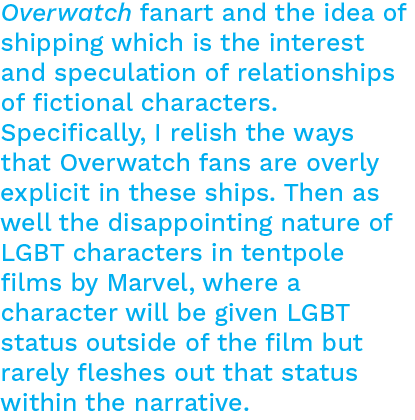FAN FICTION AND THE
ART OF SUBJECTIVITY
ELI SHOW
Art lives and dies within its audience; this idea can be traced back as far as ancient India*. An artist’s intentions are notable, but they do not always fully translate. While a work of art can live many lives throughout history, an author’s intent might die with the author. In our current society, communities are formed online through connections with a work of art, and it is within these communities that fan fiction often arises.
The creation of fan fiction is often a site of great transmutation for a work of art. Although an often maligned genre, fanfic carries within it a superpower — an act of interpretation with the ability to cheat death, express fluidity of gender/sexuality, and essentially transform that which has come before it. We are allowed to correct the course of the narrative to an internal attachment, while embracing the diverse possibilities of revised evocations.
Fanfic reflects the personal lives of those affected by a work of art. Think what you want about the psychological implications of Twilight, a YA fiction, transforming into BDSM fantasy for an older audience in Fifty Shades of Grey, but you can’t deny the implications and power this mode of expression has established. In a period where we are more and more spiritually connected to communities online rather than in real life, this connection impacts creators of properties that dominate popular culture. The art of subjectivity lies in the power to affect popular culture with stories that reflect a more diverse population, world-building opportunities that defy the hierarchies of the old guard. Fanfic as a mode of artistic creation can rewrite narrow histories to wield a more progressive story of who we are as a collective.
The ability for characters to express their sexuality with such freedom within the confines of fanfic is partly why I am so attached to this idea and genre. The fact that most of our popular media eschews sexuality while embracing violence is mystifying. It is not a coincidence that fanfic produces more free expressions of sexuality, gender and race. We have an old hierarchical system that only produces stories it deems profitable and the people in control of these systems are often not representative of the population as a whole.
When a narrative is lacking the inclusion fans desire, they may take a systemic approach to development. World-building is a term associated with the science fiction genre and relates to the idea of an author creating a world by fleshing out economic, sociological, and historical details throughout a story. When we view this concept of world-building in relation to an audience’s ability to visualize the common world we inhabit, we start to see the influence popular culture has on the collective psyche of a more diverse population. We see the impact that popular films have on a younger generation when they include more diverse casts and provide visibility to people often seen on the fringes. This validation of persona as a celebrated phenomenon versus an open secret creates a world of opportunity. This action builds worlds within the minds of an audience. We are seeing this idea slowly establishing itself in mass media with the huge popularity of genre work in sci-fi, superheroes and fantasy.
Besides fanfic’s effects on movies and books, I am also interested in how this mode exists within the confines of the visual arts. Referencing art history has been a longtime tradition within the visual arts. Fanfic as an artistic gesture is more about recontextualizing rather than referencing. Fanfic as a mode of artistic intervention is concerned with transformation over homage. Much like popular films and books, the perspective of the art world throughout history has been only male, Caucasian, and European focused. The many artists performing these gestures then are often not part of that aforementioned group.
Audrey Wollen, for example, restages classical artwork using her Sad Girl Theory. Wollen proposes that the sadness of girls should be witnessed and re-historicized as an act of resistance, of political protest. She’s taking criticisms of her generation and female objectivity head on with an action that understands the importance of visibility. In an interview Wollen states, “I think it’s important to look very hard at anything that mass culture wants to stay invisible.”
There are also creators like Carlota Guerrero whose photography and art direction reenact classical artwork creating more diverse views of the iconography of womanhood. Guerrero is a consistent collaborator with Solange. Within that same genre and act we can also view the work of Beyoncé, and more specifically the video Apeshit. Filmed within the Louvre, it’s a deliberate visualization of the power and cultural legacy of the Carters and POC women up against the predominantly white and European canon of art history. The video alone is such a complex and rich restaging of power dynamics (aside from what the title of the song implies), making for something incredibly intense but too magnificently complex to cover in a single essay.
Beyoncé’s use of symbolism and art history builds a rich and layered mythology within the video. Her very recent acquisition of an artwork by Deborah Roberts displays an acute attention to this dynamic as well. Roberts’ artwork consists of collages of black bodies in vehement displays of power and defiance. Works that challenge notions of beauty and history, using found photographs from various sources, making potent visual portraits that similarly transform their source material.
To label Roberts or any of these artists’ work as fanfic does them a disservice. I think they exist in a much more complex state that I am not fully able to translate. But the communities that these works create and the world-building that exist as a byproduct of these explorations share in the rich potential of an act of fanfic. The analogous nature of these acts of creation help build interesting ways for us as a collective to move forward in time and history. These course corrections will hopefully have a similar impact on culture as their mass media counterparts do, making visible to everyone the beauty and power of our diverse world, while allowing for the personal reflections on culture to ring out as a rallying cry behind those that don’t fit into the old molds that suffocate progress.
Fanfic reflects the personal lives of those affected by a work of art. Think what you want about the psychological implications of Twilight, a YA fiction, transforming into BDSM fantasy for an older audience in Fifty Shades of Grey, but you can’t deny the implications and power this mode of expression has established. In a period where we are more and more spiritually connected to communities online rather than in real life, this connection impacts creators of properties that dominate popular culture. The art of subjectivity lies in the power to affect popular culture with stories that reflect a more diverse population, world-building opportunities that defy the hierarchies of the old guard. Fanfic as a mode of artistic creation can rewrite narrow histories to wield a more progressive story of who we are as a collective.
The ability for characters to express their sexuality with such freedom within the confines of fanfic is partly why I am so attached to this idea and genre. The fact that most of our popular media eschews sexuality while embracing violence is mystifying. It is not a coincidence that fanfic produces more free expressions of sexuality, gender and race. We have an old hierarchical system that only produces stories it deems profitable and the people in control of these systems are often not representative of the population as a whole.
When a narrative is lacking the inclusion fans desire, they may take a systemic approach to development. World-building is a term associated with the science fiction genre and relates to the idea of an author creating a world by fleshing out economic, sociological, and historical details throughout a story. When we view this concept of world-building in relation to an audience’s ability to visualize the common world we inhabit, we start to see the influence popular culture has on the collective psyche of a more diverse population. We see the impact that popular films have on a younger generation when they include more diverse casts and provide visibility to people often seen on the fringes. This validation of persona as a celebrated phenomenon versus an open secret creates a world of opportunity. This action builds worlds within the minds of an audience. We are seeing this idea slowly establishing itself in mass media with the huge popularity of genre work in sci-fi, superheroes and fantasy.
Besides fanfic’s effects on movies and books, I am also interested in how this mode exists within the confines of the visual arts. Referencing art history has been a longtime tradition within the visual arts. Fanfic as an artistic gesture is more about recontextualizing rather than referencing. Fanfic as a mode of artistic intervention is concerned with transformation over homage. Much like popular films and books, the perspective of the art world throughout history has been only male, Caucasian, and European focused. The many artists performing these gestures then are often not part of that aforementioned group.
Audrey Wollen, for example, restages classical artwork using her Sad Girl Theory. Wollen proposes that the sadness of girls should be witnessed and re-historicized as an act of resistance, of political protest. She’s taking criticisms of her generation and female objectivity head on with an action that understands the importance of visibility. In an interview Wollen states, “I think it’s important to look very hard at anything that mass culture wants to stay invisible.”
There are also creators like Carlota Guerrero whose photography and art direction reenact classical artwork creating more diverse views of the iconography of womanhood. Guerrero is a consistent collaborator with Solange. Within that same genre and act we can also view the work of Beyoncé, and more specifically the video Apeshit. Filmed within the Louvre, it’s a deliberate visualization of the power and cultural legacy of the Carters and POC women up against the predominantly white and European canon of art history. The video alone is such a complex and rich restaging of power dynamics (aside from what the title of the song implies), making for something incredibly intense but too magnificently complex to cover in a single essay.
Beyoncé’s use of symbolism and art history builds a rich and layered mythology within the video. Her very recent acquisition of an artwork by Deborah Roberts displays an acute attention to this dynamic as well. Roberts’ artwork consists of collages of black bodies in vehement displays of power and defiance. Works that challenge notions of beauty and history, using found photographs from various sources, making potent visual portraits that similarly transform their source material.
To label Roberts or any of these artists’ work as fanfic does them a disservice. I think they exist in a much more complex state that I am not fully able to translate. But the communities that these works create and the world-building that exist as a byproduct of these explorations share in the rich potential of an act of fanfic. The analogous nature of these acts of creation help build interesting ways for us as a collective to move forward in time and history. These course corrections will hopefully have a similar impact on culture as their mass media counterparts do, making visible to everyone the beauty and power of our diverse world, while allowing for the personal reflections on culture to ring out as a rallying cry behind those that don’t fit into the old molds that suffocate progress.
Eli Show is an artist based in Sioux Falls, SD.
www.elishow.com
@elishow
www.elishow.com
@elishow
︎ READ RANDOM







